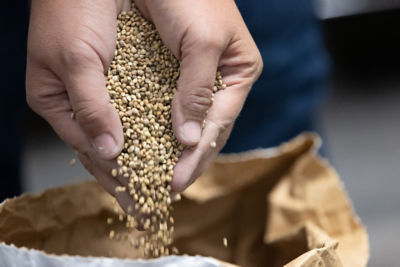Causal Agent
Cucumber mosaic virus (CMV)
Vector
Several aphid species
Distribution
Worldwide
Symptoms
All cucurbits are susceptible to CMV, but watermelon is rarely affected. Symptoms may vary based on host, environment and age of the plant at time of infection. Symptoms first appear on younger leaves, which curl downward and become mottled, distorted and reduced in size. Plants may become stunted with shortened internodes, resulting in a rosette-like appearance of the youngest leaves. If infection occurs after flowering, vine growth may not be reduced, but fruit may be mottled and distorted.
Cucumber: Seedlings seldom show symptoms during the first few weeks of growth, but symptoms can appear once growth becomes vigorous. Leaves become mottled and distorted with downward-curling edges. All subsequent growth is reduced, leaving the plants dwarfed. Older leaves may develop chlorotic margins, which later become necrotic. Fruit are often misshapen, mottled (yellowish-green), warty and reduced in size. Infected fruit may appear bleached due to a lack of chlorophyll production.
Melon: Melon plants may exhibit severely stunted growing tips. Even if fruit does not express distinct symptoms, overall fruit quality is often poor.
Pumpkin: Early infection often results in severe foliar mosaic. Fruit may be rendered unmarketable due to mosaic symptoms.
Squash: Early-season infection can result in severely stunted plants with deformed leaves. Petioles often exhibit a downward or bending growth pattern. Leaves may also be reduced in size. Fruit can become unmarketable due to pronounced rugosity of the fruit surface. In summer squash, warty raised yellow areas appear on the fruit, and are surrounded by dark green areas.
Watermelon: Foliar symptoms are often mild when compared to the other cucurbit hosts. Mild leaf crinkling with some yellowing may be observed.
 Cucumber mosaic virus leaf symptoms on cucumber. Note virus symptoms progress up the plant.
Cucumber mosaic virus leaf symptoms on cucumber. Note virus symptoms progress up the plant.
Conditions for Development
CMV can infect both greenhouse and field-grown vegetable crops. CMV has an extensive host range (>1200 species) facilitating its survival on weeds, ornamentals, and other cultivated crops. The primary mode of transmission is by aphids in a non-persistent manner, although the virus can also be mechanically transmitted through equipment and workers. Cucumber beetles (Diabrotica spp.) have also been shown to transmit CMV, but aphids are the primary vector.
Control
Management of CMV through vector control (e.g., insecticides, stylet oils) has been only marginally successful. Avoid planting near older cucurbits and perennial ornamental crops, which may serve as reservoirs for the virus. Control weeds, use reflective mulches, deep plow crop residues and dispose of infected greenhouse material to manage this virus. Implement a comprehensive sanitation program for workers and equipment to minimize disease spread. Commercial varieties with resistance offer the best means to control CMV. Resistance in cucumber has been shown to be very effective on a global scale. Progress in finding resistance in other cucurbit species has not been as successful. In yellow summer squash, the presence of the precocious yellow gene has worked well against CMV infection. A few transgenic-resistant squash cultivars are grown in the USA.



